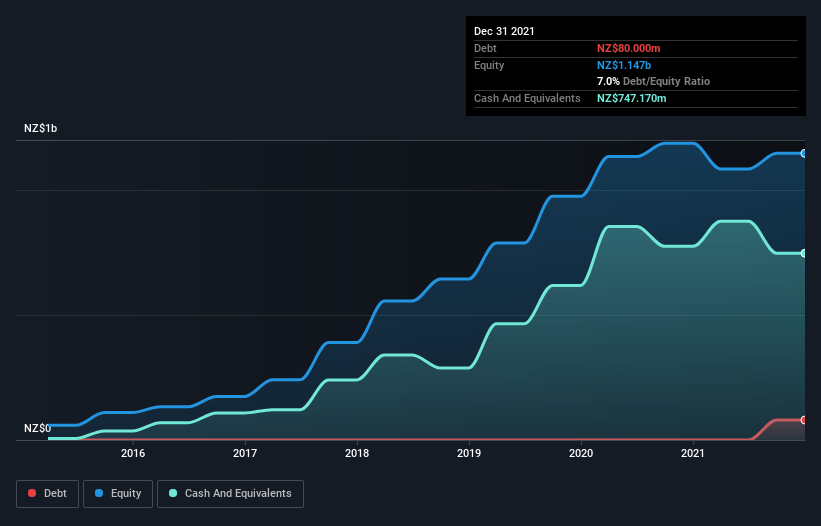
David Iben put it well when he said, 'Volatility is not a risk we care about. What we care about is avoiding the permanent loss of capital.' It's only natural to consider a company's balance sheet when you examine how risky it is, since debt is often involved when a business collapses. We can see that The a2 Milk Company Limited (NZSE:ATM) does use debt in its business. But is this debt a concern to shareholders?
What Risk Does Debt Bring?
Debt assists a business until the business has trouble paying it off, either with new capital or with free cash flow. In the worst case scenario, a company can go bankrupt if it cannot pay its creditors. However, a more common (but still painful) scenario is that it has to raise new equity capital at a low price, thus permanently diluting shareholders. Of course, debt can be an important tool in businesses, particularly capital heavy businesses. The first step when considering a company's debt levels is to consider its cash and debt together.
Check out our latest analysis for a2 Milk
What Is a2 Milk's Debt?
As you can see below, at the end of December 2021, a2 Milk had NZ$80.0m of debt, up from none a year ago. Click the image for more detail. But it also has NZ$747.2m in cash to offset that, meaning it has NZ$667.2m net cash.

A Look At a2 Milk's Liabilities
We can see from the most recent balance sheet that a2 Milk had liabilities of NZ$387.4m falling due within a year, and liabilities of NZ$78.4m due beyond that. Offsetting these obligations, it had cash of NZ$747.2m as well as receivables valued at NZ$120.5m due within 12 months. So it actually has NZ$401.9m more liquid assets than total liabilities.
This short term liquidity is a sign that a2 Milk could probably pay off its debt with ease, as its balance sheet is far from stretched. Succinctly put, a2 Milk boasts net cash, so it's fair to say it does not have a heavy debt load!
It is just as well that a2 Milk's load is not too heavy, because its EBIT was down 91% over the last year. When a company sees its earnings tank, it can sometimes find its relationships with its lenders turn sour. The balance sheet is clearly the area to focus on when you are analysing debt. But it is future earnings, more than anything, that will determine a2 Milk's ability to maintain a healthy balance sheet going forward. So if you're focused on the future you can check out this free report showing analyst profit forecasts.
Finally, a company can only pay off debt with cold hard cash, not accounting profits. While a2 Milk has net cash on its balance sheet, it's still worth taking a look at its ability to convert earnings before interest and tax (EBIT) to free cash flow, to help us understand how quickly it is building (or eroding) that cash balance. During the last three years, a2 Milk generated free cash flow amounting to a very robust 80% of its EBIT, more than we'd expect. That positions it well to pay down debt if desirable to do so.
Summing up
While it is always sensible to investigate a company's debt, in this case a2 Milk has NZ$667.2m in net cash and a decent-looking balance sheet. And it impressed us with free cash flow of NZ$195m, being 80% of its EBIT. So we are not troubled with a2 Milk's debt use. The balance sheet is clearly the area to focus on when you are analysing debt. But ultimately, every company can contain risks that exist outside of the balance sheet. For example - a2 Milk has 2 warning signs we think you should be aware of.
If, after all that, you're more interested in a fast growing company with a rock-solid balance sheet, then check out our list of net cash growth stocks without delay.
New: AI Stock Screener & Alerts
Our new AI Stock Screener scans the market every day to uncover opportunities.
• Dividend Powerhouses (3%+ Yield)
• Undervalued Small Caps with Insider Buying
• High growth Tech and AI Companies
Or build your own from over 50 metrics.
Have feedback on this article? Concerned about the content? Get in touch with us directly. Alternatively, email editorial-team (at) simplywallst.com.
This article by Simply Wall St is general in nature. We provide commentary based on historical data and analyst forecasts only using an unbiased methodology and our articles are not intended to be financial advice. It does not constitute a recommendation to buy or sell any stock, and does not take account of your objectives, or your financial situation. We aim to bring you long-term focused analysis driven by fundamental data. Note that our analysis may not factor in the latest price-sensitive company announcements or qualitative material. Simply Wall St has no position in any stocks mentioned.
About NZSE:ATM
a2 Milk
Sells A2 protein type branded milk and related products in Australia, New Zealand, China, rest of Asia, and the United States.
Excellent balance sheet with acceptable track record.
Similar Companies
Market Insights
Community Narratives



